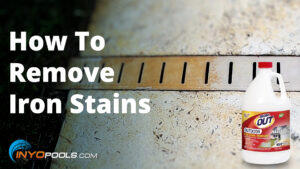You think your pool is leaking? Oh boy. OK, first thing, do not attempt to look for a leak in an above ground swimming pool if you only think it has a leak. Instead, only attempt to find a leak in a pool when you know it has a leak. This simple rule will save you a lot of unnecessary irritation. As I write this blog post, there are many people (maybe thousands) who are looking for something that isn’t there. Trust me, it’s true. You may even be one of them. I’ve heard pool owners say things like, “My pool only leaks in the fall” and “My pool was leaking and then it stopped.” These types of statements usually tell me that it probably doesn’t have a leak and is instead losing water due to evaporation.
So How Do I Make Sure My Pool Is Leaking?
Evaporation is by far the main factor that causes people to think their pool has a leak when it doesn’t, but there are a couple of other reasons. Pay close attention to your swimming activity. If there are many kids active in the pool, they could be responsible for a lot of water loss. A kid can pull up to four gallons of water with him/her when he/she gets out of the pool. So, if a few kids are splashing around a lot and jumping in and out constantly, the water loss can add up. Also, do you maybe have an uncle that likes to help around the place whether you want him to or not? Perhaps he is backwashing your sand filter twice a week or draining some pool water after it rains and you don’t know he’s doing it. Make sure of these things before you say your pool has a leak.
Back to evaporation. Finding out how much water your pool is losing due to evaporation requires two things some people have difficulty with – time and consistency. Give it at least a week and do the following eleven things:
- Fill a bucket with exactly 12 inches of water and place it right next to the pool.
- Make sure the bucket doesn’t leak and that no one messes with the bucket.
- Mark the water level on the bucket.
- With the pool pump off, carefully mark the water level of the pool. It won’t be as easy to do as it sounds and may take practice. Use a nonpermanent marker or good tape.
- For best results, don’t allow any swimming for the week. Don’t backwash either.
- Every 24 hours, mark the bucket’s water level and the pool’s water level next to the other marks that you made prior .
- Repeat this for at least a week and do it accurately.
- If I understand correct, when evaporation occurs the next marks will not be next to the other marks. The use of “next to” might confuse the readers. I suggest you instead write, “Every 24 hours, mark the bucket’s water level and the pool’s water level below the other marks that you have made prior.”
- After a week, measure the distance between the marks that you have measured every 24 hours on the bucket.
- Measure the distance between the marks that you have measured every 24 hours in the pool.
- Compare the recorded distances from the bucket and the pool.
- If the distances from the pool’s marks are greater, you have a leak.
- If the distances from the bucket’s marks are greater, your dog is drinking out of the bucket. Leave the dog in the house for a week and repeat above steps.
If I understand correct, when evaporation occurs the next marks will not be next to the other marks. The use of “next to” might confuse the readers. I suggest you instead write, “Every 24 hours, mark the bucket’s water level and the pool’s water level below the other marks that you have made prior.”
The natural rate of evaporation will vary depending on where you live and what time of year it is. I’ve read that the maximum loss due to evaporation is a third of an inch every 24 hours. This amount is an extreme example that would only occur somewhere in the desert like Phoenix in the late summer. Here in Orlando, the most loss that I have recorded was about a quarter of an inch every 24 hours. Usually it is much less or about an eighth of an inch every 24 hours.
The drier the air, the more water your pool will lose due to evaporation. Sadly, I was a pool guy for years here in Central Florida before I realized that. Our summers are so humid and hot here that I thought the summer was when we had most loss due to evaporation. It wasn’t until I spent a few years marking pools and observing the results that I determined that the fall’s dry air causes the greatest rate of evaporation. So for all you blog skimmers and those bad at math, here’s a bold statement: If your pool is losing more than a third of an inch of water a day, it probably has a leak.
When It Rains, Water Is Added to Your Pool
Call me Captain Obvious all you want, but it’s worth mentioning. In Florida the air gets drier in the fall. It also doesn’t rain nearly as much which is another trigger for pool owners to think they have a leak. Now you may not be surprised at the amount of inquiries I get every fall regarding pools losing water. In the summer when it’s raining at least a few times a week, people get used to their pools having lots of water in them. They may even have to drain them occasionally. Now it’s October and all of a sudden they look out and the pool’s water level is a little low. Some then will think, “Wow, the pool’s water level is low. I must have a leak.” Maybe they do have a leak, but they probably don’t. It just stopped raining as much. Every area has a different rain pattern and dry season so please keep this in mind before you freak.
Certainly it can be stressful to think your swimming pool is leaking. My advice is take a breath and follow the steps to make sure you do in fact have a leak. It may very well not be leaking. Sometimes it’s just normal for the time of year. If you follow the above steps and find that your pool is in fact losing more water than can be attributed to evaporation, then by all means, freak out. Afterwards, find my blog post on how to find a leak in an above ground pool and then you can calm down.
If I understand correct, when evaporation occurs the next marks will not be next to the other marks. The use of “next to” might confuse the readers. I suggest you instead write, “Every 24 hours, mark the bucket’s water level and the pool’s water level below the other marks that you have made prior.”
If you have any questions on your above ground pool then we would be happy to help, feel free to give us a call at 1-877-372-6038 or email us at upload@inyopools.com If you liked this article then make sure to sign up for Blog and get our Free 128 Page Pool Care Guide.












Leave a Reply